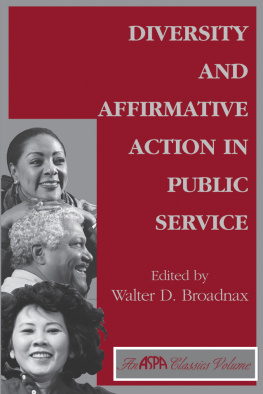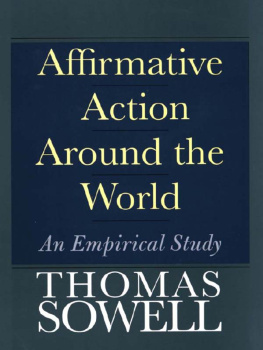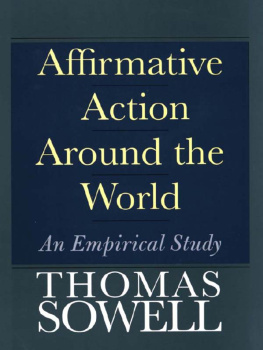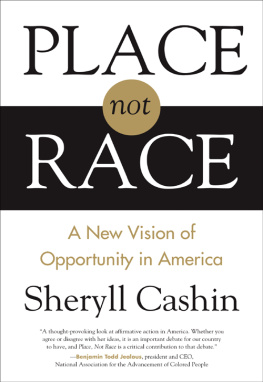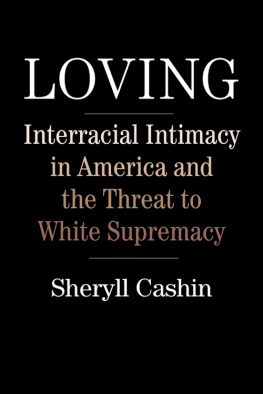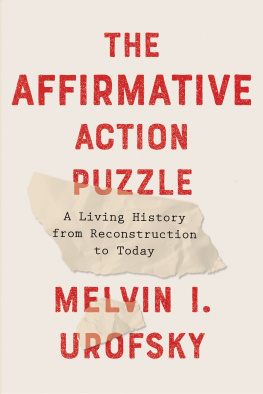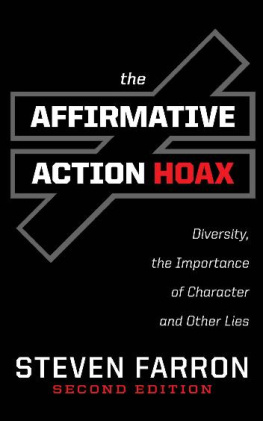Diversity and Affirmative Action in Public Service
ASPA CLASSICS
Conceived and sponsored by the American Society for Public Administration (ASPA), the ASPA Classics series will publish volumes on topics that have been, and continue to be, central to the contemporary development of public administration. The ASPA Classics are intended for classroom use, and may be quite suitable for libraries and general reference collections. Drawing from the Public Administration Review (PAR) and other journals related to the ASPA sections, each volume in the series is edited by a scholar who is charged with presenting a thorough and balanced perspective on an enduring issue. These journals now represent some six decades of collective wisdom. Yet, many of the writings collected in the ASPA Classics might not otherwise easily come to the attention of future public managers. Given the explosion in research and writing on all aspects of public administration in recent decades, these ASPA Classics anthologies should point readers to definitive or groundbreaking authors whose voices should not be lost in the cacophony of the newest administrative technique or invention.
Public servants carry out their responsibilities in a complex, multi-dimensional environment. The mission of ASPA Classics is to provide the reader with a historical and first hand view of the development of the topic at hand. As such, each ASPA Classics volume presents the most enduring scholarship, often in complete, or nearly complete, original form on the given topic. Each volume will be devoted to a specific continuing concern to the administration of all public sector programs. Early volumes in the series address public sector performance, public service as commitment, and diversity and affirmative action in public service. Future volumes will include equally important dialogues on classic ideas as enduring ideas, reinventing government, public budgeting, and public service ethics.
The volume editors are to be commended for volunteering for the substantial task of compiling and editing these unique collections of articles which might not otherwise be readily available to scholars, teachers, and students.
ASPA Classics Editorial Board
Marc Holzer, Editor-in-Chief
Rutgers University, Campus at Newark
Walter Broadnax, American University
Beverly Cigler, Pennsylvania State University
Patricia Ingraham, Syracuse University
Richard C. Kearney, East Carolina University
Don Kettl, University of Wisconsin
Camilla Stivers, Cleveland State University
Books in This Series
Diversity and Affirmative Action in Public Service , edited by Walter D. Broadnax
Public Service: Callings, Commitments, and Constraints, edited by Marc Holzer
Public Sector Performance: Management , Motivation, and Measurement , edited by Richard C. Kearney and Evan M. Berman
Diversity and Affirmative Action in Public Service
edited by
Walter D. Broadnax
American University
An ASPA Classics Volume
First published 2000 by Westview Press
Published 2018 by Routledge
711 Third Avenue, New York, NY 10017, USA
2 Park Square, Milton Park, Abingdon, Oxon OX14 4RN
Routledge is an imprint of the Taylor & Francis Group, an informa business
Copyright 2000 by Taylor & Francis
All rights reserved. No part of this book may be reprinted or reproduced or utilised in any form or by any electronic, mechanical, or other means, now known or hereafter invented, including photocopying and recording, or in any information storage or retrieval system, without permission in writing from the publishers.
Notice:
Product or corporate names may be trademarks or registered trademarks, and are used only for identification and explanation without intent to infringe.
Library of Congress Cataloging-in-Publication Data
Diversity and affirmative action in public service/edited by Walter D. Broadnax.
p. cm.(ASPA classics)
Includes bibliographical references and index.
ISBN 0-8133-6691-7 (hc.)ISBN 0-8133-6690-9 (pbk.)
1. Diversity in the workplace. 2. Affirmative action programs. 3. Civil
serviceMinority employment. I. Broadnax, Walter D. II. Series.
HF5549.5.M5 D55 1999
331.13'3'0973dc21
99-048881
ISBN 13: 978-0-8133-6690-6 (pbk)
As readers examine this volume, they will discover that there are five sections and the subject matter ranges from a discussion of representative bureaucracy and equal employment opportunity to aging and disabilities as an important aspect of diversity and affirmative action in the United States. Each section provides a somewhat different perspective on the subject of differences, particularly differences found in a public service context. However, the themes of equal opportunity, diversity, and affirmative action run through each chapter and take on their own nuance in relation to the overall themestrategies for inclusion of those seeking greater entry or access to active participation in the American public service.
The study of public administration is a relatively young enterprise, having only emerged within the political science literature near the turn of the century. Therefore, on the one hand, it only makes sense that the number of contributions might be smaller for this specific domain. On the other hand, the subject of race and differences has captured a substantial amount of our national psychic energy. And yet, it seems to occupy such a small part of the scholarly materials produced between the inception of PAR and now. One hint as to why may be found in the number of minorities pursuing scholarship in this policy and management arena as well as the discomfort the subject often causes, still, in polite society within our country today.
Diversity, race, and gender are words that elicit for most Americans images of struggle, strife, and even violence. Whether we are talking about the antebellum South or the desegregation of Central High School in Little Rock, Arkansas, ending discrimination has been a long and difficult struggle, and too often that struggle has been etched with violence. However, it was out of a violent period in our history that the subject of African Americans in public service emerged as a serious topic of discussion and scholarship.
As Americans sat in front of their television sets in 1957 watching the mobs trying to deny black children seats in an all-white school, many began to realize that something needed to be done to prevent these kinds of eruptions from occurring on a regular basis. But even with the anxiety created by the desegregation of our schools in the 1950s and early 1960s, not until the Watts riots of 1964, the Detroit riots of 1967, and the riots that followed Dr. Martin Luther King's assassination in 1968 was there a rallying cry demanding that something must be done.
The desire to make America more inclusive took on new meaning during die late 1960s and early 1970s. The idea that society was pulling itself apart was widely accepted. Between what came to be called the Civil Rights Movement and the war in Vietnam, our streets were too often filled with rioters, looters, and other forms of dissident behavior. But public action was required to do something about the situation. In Little Rock, we saw the police and then the National Guard facilitating the desegregation of Central High School, and public sector intervention was required to quell riots in Los Angeles, Detroit, Washington, D.C., and numerous other cities across the land. With each intervention, it became increasingly clear that in order for our public service to be fully effective as well as perceived as being fair, it would have to include people of color that is, it would have to diversify.


